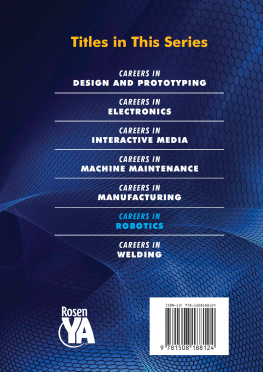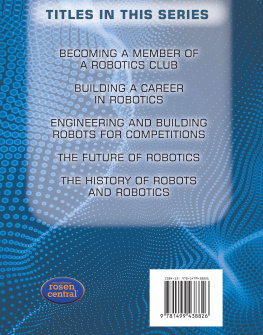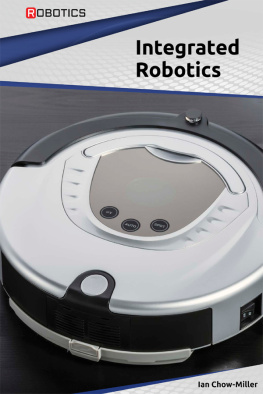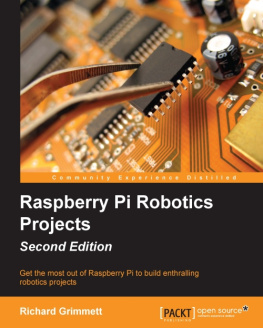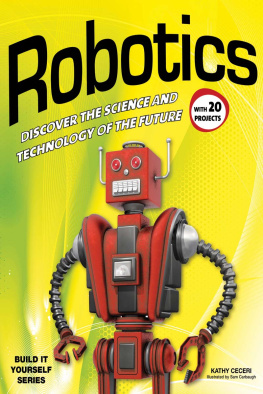
Intelligent Robotics and Autonomous Agents
Edited by Ronald C. Arkin
Dorigo, Marco, and Marco Colombetti, Robot Shaping: An Experiment in Behavior Engineering
Arkin, Ronald C., Behavior-Based Robotics
Stone, Peter, Layered Learning in Multiagent Systems: A Winning Approach to Robotic Soccer
Wooldridge, Michael, Reasoning about Rational Agents
Murphy, Robin R., An Introduction to AI Robotics
Mason, Matthew T., Mechanics of Robotic Manipulation
Kraus, Sarit, Strategic Negotiation in Multiagent Environments
Nolfi, Stefano, and Dario Floreano, Evolutionary Robotics: The Biology, Intelligence, and Technology of Self-Organizing Machines
Siegwart, Roland, and Illah R. Nourbakhsh, Introduction to Autonomous Mobile Robots
Breazeal, Cynthia L., Designing Sociable Robots
Bekey, George A., Autonomous Robots: From Biological Inspiration to Implementation and Control
Choset, Howie, Kevin M. Lynch, Seth Hutchinson, George Kantor, Wolfram Burgard, Lydia E. Kavraki, and Sebastian Thrun, Principles of Robot Motion: Theory, Algorithms, and Implementations
Thrun, Sebastian, Wolfram Burgard, and Dieter Fox, Probabilistic Robotics
Matari, Maja J., The Robotics Primer
Wellman, Michael P., Amy Greenwald, and Peter Stone, Autonomous Bidding Agents: Strategies and Lessons from the Trading Agent Competition
Floreano, Dario, and Claudio Mattiussi, Bio-Inspired Artificial Intelligence: Theories, Methods, and Technologies
Sterling, Leon S., and Kuldar Taveter, The Art of Agent-Oriented Modeling
Stoy, Kasper, David Brandt, and David J. Christensen, An Introduction to Self-Reconfigurable Robots
Lin, Patrick, Keith Abney, and George A. Bekey, editors, Robot Ethics: The Ethical and Social Implications of Robotics
Weiss, Gerhard, editor, Multiagent Systems , second edition
Vargas, Patricia A., Ezequiel A. Di Paolo, Inman Harvey, and Phil Husbands, editors, The Horizons of Evolutionary Robotics
Murphy, Robin R., Disaster Robotics
Cangelosi, Angelo, and Matthew Schlesinger,
Developmental Robotics: From Babies to Robots

2015 Massachusetts Institute of Technology
All rights reserved. No part of this book may be reproduced in any form by any electronic or mechanical means (including photocopying, recording, or information storage and retrieval) without permission in writing from the publisher.
MIT Press books may be purchased at special quantity discounts for business or sales promotional use. For information, please email .
This book was set in ITC Stone Serif Std by Toppan Best-set Premedia Limited, Hong Kong.
Library of Congress Cataloging-in-Publication Data
Cangelosi, Angelo, 1967
Developmental robotics : from babies to robots / Angelo Cangelosi and Matthew Schlesinger; foreword by Linda B. Smith.
pages cm.(Intelligent robotics and autonomous agents)
Includes bibliographical references.
ISBN 978-0-262-02801-1 (hardcover : alk. paper) 1. Autonomous robots. 2. Machine learning. 3. Robotics. 4. Self-organizing systems. I. Schlesinger, Matthew, 1967 II. Title.
TJ211.495.C36 2015
629.892dc23
2014012489
10 9 8 7 6 5 4 3 2 1
To my parents Vita and Salvatore (AC)
To Angie, Nick, and Natalie (MS)
Contents
Foreword
Linda B. Smith
The dominant method of science is analysis and simplification. This was clearly articulated by Descartes in 1628: In studying any phenomenon, simplify it to its essential components, dissecting away everything else. This approach is motivated by the belief that complicated systems will be best understood at the lowest possible level. By reducing explanations to the smallest possible entities, the hope is that we will find entities that are simple enough to fully analyze and explain. The spectacular success of this methodology in modern science is undeniable. Unfortunately, it has not given us an understanding of how systems made up of simple elements can operate with sufficient complexity to be autonomous agents. Building artificial agents who can act and adapt in complex and varying environments requires a different kind of science, one that is principally about integration and complexity rather than analysis and simplification. The theoretical task of understanding of developmental process in biological systems also requires a science of integration.
Developmental robotics is based on the premise that principles of developmental process are the key to engineering adaptive and fluid intelligence. Although the promise of this idea is not yet fully realized, remarkable progress has been made over the last decade and half. This book presents the current state of the art. In so doing, the authors also make a case for deeper collaborations between developmental roboticists and developmental psychologists. At present the ties are weak. We are working on related problems, reading the same literatures, sometimes participating in joint conferences, but only rarely actually collaborating in a sustained way. I firmly believe that remarkable gains could be made in both fields through programmatic research by teams of researchers in human development and robotics. For developmental psychology, the promise is both better theory and new ways to test theories by manipulating the pathways and experiences using artificial developing intelligent systems. Accordingly, in this foreword, I highlight seven fundamental aspects of the human developmental process that might be better understood through developmental robotics.
1. Extended immaturity. Development, like evolution and culture, is a process that creates complexity by accumulating change. At any moment, the developing agent is a product of all previous developments, and any new change begins with and must build on those previous developments. Biological systems that are flexibly smart have relatively long periods of immaturity. Why is this? Why and how does slow accumulative intelligence yield higher and more abstract forms of cognition? One possibility is that a slow accumulative systemone that does not settle too fastcan acquire the massive amounts of experience that yield multiple layers of knowledge at multiple granularities. A second related possibility concerns what developmentalists sometimes call readiness and what recent research in robotics has called learning progression. As learning progresses, new structures and new ways of learning emerge so that that the same experiences later in development have different effects on the learning system than those experiences earlier in development. If these ideas are correct, then the developmental pathway itself may be part of the explanation as to why human intelligence has the properties that it does. It simply may not be possible to shortcut developmentto try to build just the adult systemand achieve fluid and adaptive intelligence that characterizes biologically developing systems.
2. Activity. Learning experiences do not passively happen to infants. Piaget described a pattern of infant activity that is highly illustrative of this point. He placed a rattle in a four-month-old infants hands. As the infant moved the rattle, it would both come into sight and also make a noise, arousing and agitating the infant and causing more body motions, and thus causing the rattle to move into and out of sight and to make more noise. The infant has no prior knowledge of the rattle but discoversthrough activitythe task and goal of rattle shaking. As the infant accidentally moves the rattle, and sees and hears the consequences, the infant will become captured by the activitymoving and shaking, looking and listeningand incrementally through this repeated action gain intentional control over the shaking of the rattle and the goal of making noise. Action and exploration creates opportunities for learning and new tasks to be conquered. This role of action is well covered in this book and is an area in which developmental robotics is clearly demonstrating its relevance to theories of development.
Next page


